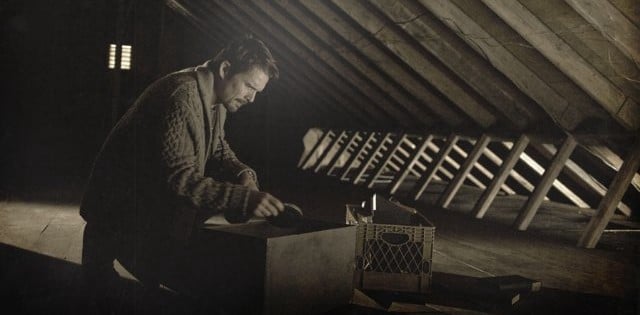
Editor’s note: This review has previously appeared as part of our SXSW 2012 and Fantastic Fest coverage, but since it’s so well-written and increasingly relevant thanks to Sinister’s opening this week, it’s back!
In recent years the found footage style of horror has been done, pardon me, to death. Whole films have been cobbled together with bits of the fake stuff in service to pretend storylines, delivered to their audiences in tidy packages that often place style over substance. In Scott Derrickson’s Sinister (this year’s SXSW “secret” screening), the found footage conceit is instead used as a source of information and scares, a clever little bit of storytelling that delivers the creeps with ease.
Derrickson’s film (co-written with C. Robert Cargill) centers on Ethan Hawke as a true crime writer who has stumbled on his biggest gig yet – penning a book about the mysterious deaths of four family members, hung from a tree in their own backyard in a ritualistic manner. Not only is the perpetrator of the crime still at large, but a fifth member of the family (the youngest girl) who disappeared after the crime is still missing. Hawke’s Ellison routinely moves his family to new towns that have been struck by some sort of tragedy, tragedies that Ellison investigates and writes about to some apparent acclaim. But it’s been years since Ellison had a hit, and it’s imperative that Ellison’s next book is one, just for simple financial reasons.
That desire has led Ellison and the family to their next home, but Ellison has gone perhaps a bit too far this time – he’s moved his wife and kids into the house that actually belonged to the slain family. And, surprise surprise, he’s found a box of home movie footage in the attic, Super 8 films that show both Ellison and the audience much more than happy picnics and giddy Christmases – and far more people than the deceased former inhabitants of the house. With the footage he finds, Ellison uncovers a series of murders that stretch back through the years and that occurred in a number of states – all killings of families where one child disappeared after the event. A skilled detective in his own right, he begins to piece together something very different than any other crime he’s ever investigated, one marked not just by brutal (and admittedly, quite inventive) violence, but a lingering sense of something otherworldly and paranormal. And other things keep happening, too – creepy noises from the attic, Ellison’s projector seemingly turning itself on in the middle of the night, and increasingly intense night terrors for Ellison and Tracy’s (Juliet Rylance) son Trevor (Michael Hall D’Addario).
It’s all scary enough already, but Hawke’s performance pumps it up to something consistently compelling. Cargill and Derrickson have written Ellison not to be just a standard horror film hero who yelps and runs and smacks at things, but a character who feels rooted in the real world, complete with real world actions, even if they look stupid to those of us in the audience, those of us used to thinking, “oh, hell no, don’t even go there.” As an investigator by nature and trade, Ellison just has to look when things go bump in the night, and Hawke conveys that with an ease that’s marvelously compelling to watch.
The first half of Sinister lingers a bit, taking its time in order for us to better know Ellison and to get a grasp on the scope of what he’s uncovering. But when those lingering creepy feelings start to deliver with real action in the film’s second half, they really deliver. The inherent terror of what’s on those found films, coupled with the reality of what they might amount to, pumps Sinister up with enough scares for audience members looking to both jump out of their seat and get their minds worked over in a big way.
The Upside: An intelligent spin on the found footage trope; solid scares in the second half; Ethan Hawke’s performance.
The Downside: The slow burn first half is more draggy than incendiary; the rest of Ellison’s family could stand to be more fleshed out.
